#Mythological tales
Text
Discover "Siren's Song" – Free Prequel to the Ravenglass Legends Series!
I am thrilled to announce that my latest story, “Siren’s Song”, a prequel to Ravenglass Legends series, is now available to read for FREE on Ream!
In this gripping tale, a haunting melody lures ships to their doom on the treacherous Braun Sea.
When Ragnar, the young heir to the chieftain, learns of the mysterious disappearances, he defies his father and sets sail with his loyal friend Kest to…
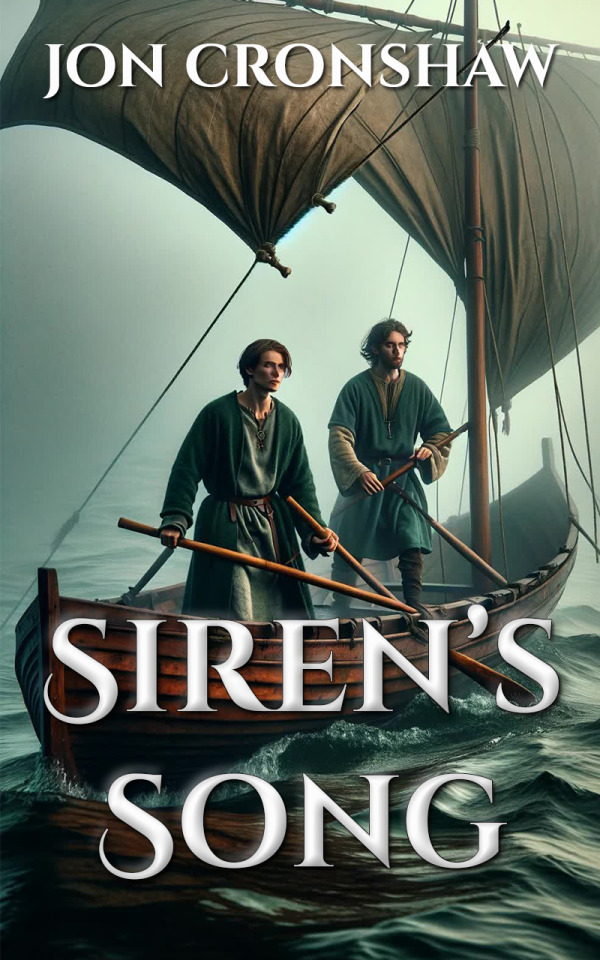
View On WordPress
#chieftain saga#fantasy adventure series#fantasy book series#free ebook download#free fantasy novel#free fantasy story#free reading on Ream#Jon Cronshaw author#Maritime Fantasy#mythological tales#new book release#new fantasy release#Ravenglass Legends prequel#Ravenglass Universe#sea adventure book#shipwreck mystery#siren myths#Siren&039;s Song#young heir adventure
0 notes
Text
#Bhimakali Temple#Sarahan#Himachal Pradesh#Goddess Bhimakali#Hindu Temple#Religious Pilgrimage#Himalayan Architecture#Traditional Style#Religious Significance#Mythological Tales#Spiritual Experience#Panoramic Views CulturalHeritage#Dussehra Festival#Sacred Sanctuary#Devotional Journey#Himalayan Beauty#Divine Energy#Spiritual Upliftment#Pilgrimage Destination
0 notes
Text
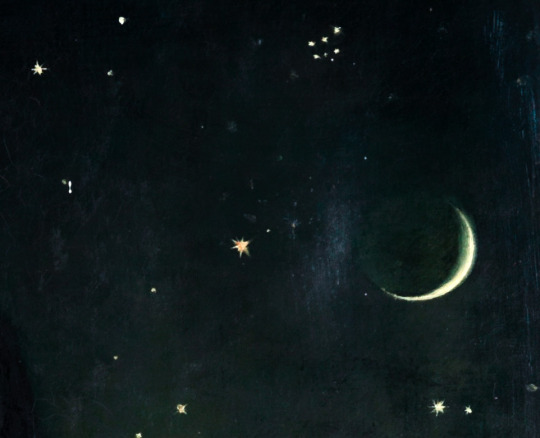

Details: Portrait of Urania, 19th century, British School.
#aesthetic#art#details#art detail#moon#art history#painting#academia#night#stars#urania#paintings#tale#space#mythology#witch#witchcraft#witchblr
17K notes
·
View notes
Text
Kartikeya: The Mighty Warrior God of Hindu Mythology
Discover the heroic deity of Kartikeya, the mighty warrior god of Hindu mythology. Join us as we explore the captivating tales, symbolism, and cultural significance surrounding this revered figure known for his valor and leadership in battle.
Section 1: Birth and Divine Significance
The birth of Kartikeya is a fascinating mythological tale that holds deep significance in Hindu mythology.…

View On WordPress
#Birth of Kartikeya#Deva-Asura wars#Dharma#Divine attributes#Epic battles#God of War#Hindu Mythology#Kartikeya#Leadership#Legends#Mighty warrior#Mythological tales#righteousness#Significance#Surapadman#Symbolism#Tarakasura#Triumphs#Valiant deity
1 note
·
View note
Text
i love you fairy tales i love you folklore i love you myths i love you stories as old as humanity itself i love you oral traditions i love you characters carried through time on my ancestors’ tongues i love you story i’ve seen a million ways and want to see a million more i love you archetypes i love—
19K notes
·
View notes
Text
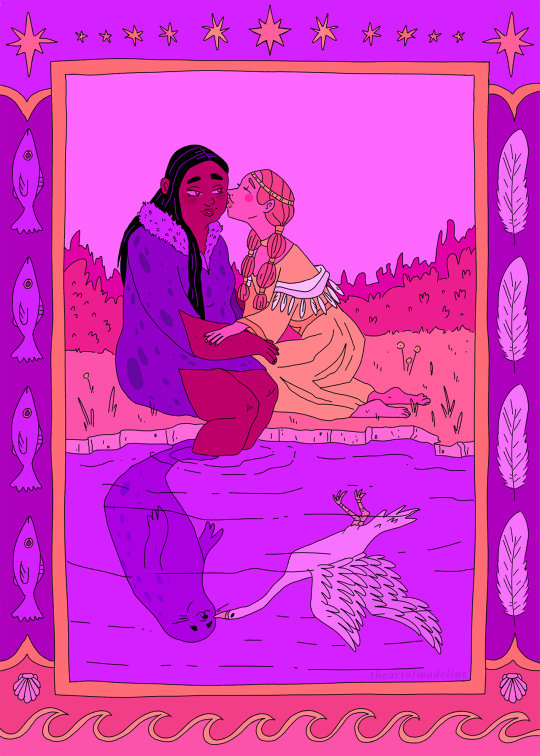
me, waking up in a cold sweat: selkie and swan maiden girlfriends
#lesbian#queer#wlw#illustration#art#digital art#selkie#swan maiden#fairy tale#artwork#original art#artists on tumblr#lgbt#lgbtq#sapphic#mythology#theartofmadeline#ive been thinking A LOT about selkies & swan maidens#and i think they should date#no ownership over each other….#mutual love and understanding….
2K notes
·
View notes
Text
I find it interesting that people talk and write about fairies these days like they're these horrible, Machiavellian monsters that you mustn't ever risk dealing with. Even saying your name near them will forever put you in their thrall, forever! (Or something to that effect)
But when you dig into the folklore, you find countless stories of fairies just getting dunked on in just the daftest ways.
I've been reading "The Lore of Scotland", by Jennifer Westwood and Sophia Kingshill, and when I noticed this trend, I started taking count of who wins in fairies vs. human confrontations. I'm only about a fifth through, and while it's not clear cut, the humans are winning by three points!
By way of example, let me tell you one of my favourite stories so far. Once upon a time, a young woman was abducted by the fay and carried away to a fairie mound. There, she was placed in the arms of the great fay giantess who ruled those halls.
"I've got you now!" said the giantess, "I'm going to hold you as tight and as close as vine on tree, forever more!"
Certainly in a pickle, the young woman considered her dire situation and simply replied, "I wish it was shit you were holding."
The fay giantess was so completely appalled and disgusted by the coarse manner of the young woman that she let her go immediately and had her taken back to her home.
Not only do I find this really funny, I enjoy the fact that even centuries ago, the forthright manner and direct problem solving of Scottish women was well established.
967 notes
·
View notes
Photo
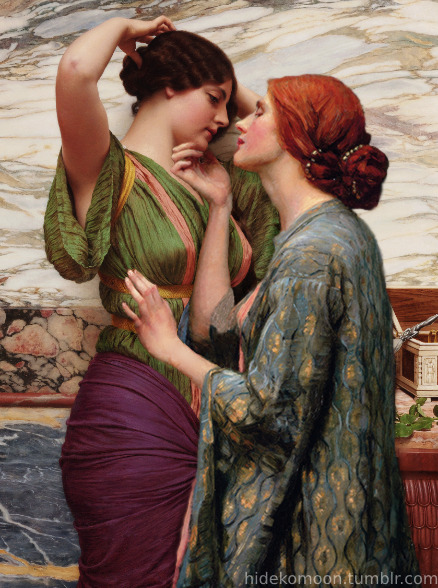

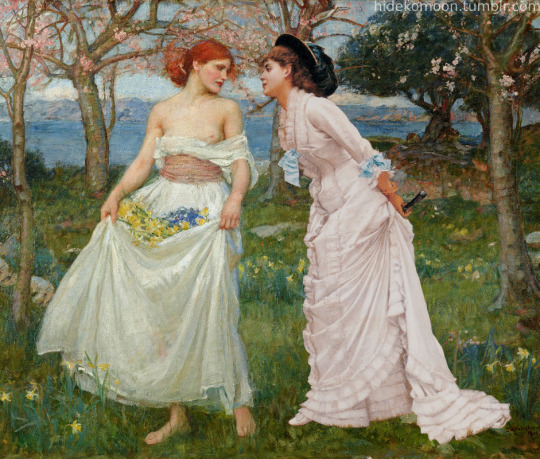


I did it again (my other edits here)
1. Godward’s A Fair Reflection (1915) and Waterhouse’s The Soul of the Rose (1908)
2. Frank Cadogan Cowper’s Damsel of the Lake (1924) kissing the lady in Auguste Toulmouche’s The Kiss (c.1870)
3. Waterhouse’s A Song of Springtime (1913) and Auguste Toulmouche’s Woman and Roses (1879)
4. Evelyn De Morgan’s Ariadne in Naxos (1877) with Waterhouse’s Sweet Summer (1912)
5. A woman from Charles Perugini’s Dolce Far Niente (1882) about to wake up Victor Gilbert’s Sleeping Beauty (date unknown)
please reblog if you save! (except terfs, “gender critical” radfems and general transphobes, y’all can block me please)
#painting#collage#john william waterhouse#lesbian#medievalcore#arthurian legend#sapphic#pre raphaelite#greek mythology#fairy tales#preraphaelism#auguste toulmouche#art history#john william godward#wlw#mine#not strictly preraphaelite this time#i just went and picked the most convenient poses
6K notes
·
View notes
Text

Baba Yaga’s hut, my beloved 🐓🏠
#drawing#digital art#fantasy art#folklore#Slavic folklore#fairy tale art#baba yaga#mythology#illustration#sketch
597 notes
·
View notes
Text

Grimm’s Household Tales
Edited and partly translated anew by Marian Edwardes
E. P. Dutton & Co
New York
1912
Artist : R. Anning. Bell
Princess and the Dragon
#brothers grimm#frères grimm#children's literature#fairy tale#children's books#vintage illustration#fairy story#children's book#fairy tales#old illustration#1912#Princess#dragon#cloués#nuages#sea#mer#ocean#mythological creature#fantastic creatures
282 notes
·
View notes
Text
I think people sleep on this moment in the Odyssey...
If I'm wrong, not getting full context, or see something that isn't there, feel free to give evidence to explain why.
Here he crept under a pair of bushes, one an olive, the other a wild olive, which grew from the same stem with their branches so closely intertwined that when the winds blew moist not a breath could get inside, nor could the rain soak right through to the earth.
(Book 5, Rieu)
I think this is about Penelope and him.
Obviously, their marriage bed is made from an Olive tree. If it's just about Athena then why are there two mentioned? Why did Homer mention two when he could've just said he took refuge under one? Or a completely different type of tree? Why mention them being intertwined?
One an olive: Penelope, who has been with society and "safe" in Ithaca ("Safe" because of the suitors)
One wild: Odysseus, who has dealt with literal monsters and immortals and has just escaped from Calypso. Literally naked and filthy, a "wild man".
"which grew from the same stem with their branches": Them both being together at first, before being separated.
"so closely intertwined that when the winds blew moist not a breath could get inside, nor could the rain soak right through to the earth.": Despite being separated, they are still "intertwined". Whether you want to think of it as them being likeminded or simply connected, even though they are apart, nothing could get in between them. 🥺
I don't know what else Homer could be referring to other than them.
#It's funny to me as even though she's not always mentioned when he retells his tale to the Phaeacians. The narrator mentions her CONSTANTLY#Because even if Odysseus doesn't say it. He's thinking about her often#honestly I...I don't think it COULD be anything else but I'm sure people will be mad that the simp loves his wife. 🤷#This part is the reason why I mention them calling the bed their “nest” as that's what THIS part calls it too. and I find it really cute#It was a nest where he SHOULD have stayed in with his family but no... :'D#half-empty nest😞#also it could be him comforting himself??? He's been forced to be in beds he doesn't want to be in for YEARS#Now. he's free and while it's not “fancy”. but at least it's SOMEWHAT like his own#greek mythology#tagamemnon#odyssey#the odyssey#penelope#odysseus#odypen#odysseus and penelope#odysseus x penelope#Mad rambles#shot by odysseus#essay
201 notes
·
View notes
Text
#Dev Pashakot Temple#Mandi#Himachal Pradesh#Hinduism#Religious Heritage#Temple Architecture#Spiritual Sanctuary#Divine Blessings#Panoramic Views#Mountain Retreat#Cultural Significance#Mythological Tales#Serene Ambiance#Festival Celebration#Pilgrimage Destination#Himalayan Serenity#Sacred Energy#Devotional Journey#Historical Legacy#Nature Beauty
0 notes
Text
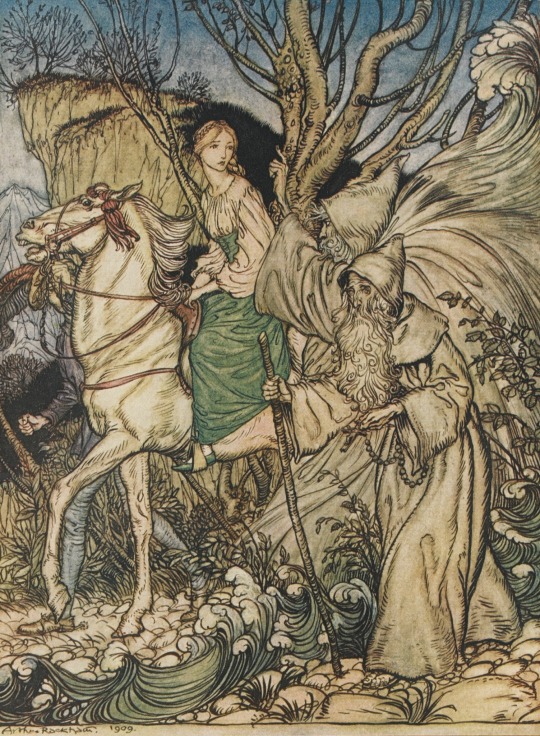
Undine by Arthur Rackham
#undine#art#arthur rackham#illustration#friedrich de la motte fouqué#fairytale#fairy tale#germany#german#water spirit#mythology#mythological#supernatural#soul#medieval#knight#europe#european#romance#paracelsus#esoteric#ondine#fairy tales#folklore#fairy#mermaid#history#romantic
334 notes
·
View notes
Text
Running Commentary: What is “ok to do” in Mixed-Culture Supernatural Fiction?
Dear readers:
Today we are trying something new. To give you some insight into our process in the Japanese moderator section, we are presenting our response in the form of running commentary to show you how we dissect and answer long asks. We hope this makes clear what points are useful and not useful when sending us a query. As always, this is for learning purposes, not callouts. Be prepared: this is a long one.
To summarize: the asker is looking to create a comic drawn in Japanese manga style, and has provided a long summary of the story and worldbuilding which involves a mix of “reimagined” Japanese yokai mythos and cultural symbols from many other sources. They have questions with respect to cultural appropriation, coding etiquette, and “what is and isn’t ok.”
Opening Comments
I know a common advice when it comes to the thing I am about to ask is to talk to people involved in __, but I struggle with opening up to strangers for reasons I'm uncomfortable explaining.
Marika (M): This is already a red flag. If you want to engage with another culture without talking to people from that culture, then research is going to be very challenging. You won’t have members of that culture to guide you towards sources and perspectives they feel most accurately represents public opinion. If I were in your shoes, I might start with tackling my discomfort when engaging with other people, if only to improve my work. If you aren’t ready to engage with a culture and its people directly, then I think you should wait until you are.
I should note, reaching out to the Japanese mod team at WWC does count as engagement, but WWC should not and cannot be the only point of contact because there is no single, legitimate cultural perspective.
Rina (R): Also, you don’t need to “open up” to strangers or talk to them in person to get perspectives. Asking specific research questions anonymously to a forum or on social media requires very little vulnerability. You managed to do it here on WWC. So give it a try!
Anyway, my question basically amounts to the what is and isn't ok [sic] in terms of depicting fantasy creatures and concepts outside of their respective culture.
R: So, the reason why we turn away rubber stamp questions by that ask “is XYZ okay?” is because “okay” & “not okay” 1) is vague and 2) creates a dichotomy where there isn’t one.
When we say something is “not okay,” do we mean:
It’s offensive to the general majority of XYZ group?
It’s contentious among people who ID in the group?
It has a potential to be interpreted in a certain negative way, but may not be a red flag to everyone?
Insetad try asking:
What are the reasons this subject is offensive?
What makes cultural appropriation bad?
When might it be “okay” to intentionally discuss a difficult or controversial topic?
What is your reason for including something that may be interpreted as offensive and can it be sufficiently justified?
What stereotypes or tropes might it be consistently identified as or associated with, and why?
When might it be justified to bring up these tropes?
With That In Mind...
Let’s get into the rest of the ask below.
…a story I've been working on in recent times is largely inspired off the Japanese yokai, and the setting is basically Earth in the far future, as far as when the next supercontinent may form. These yokai, although portrayed differently here, do retain their main characteristics [...] Included in this world are two goddesses of my own creation, primarily representing the sun and the moon. [...] There will be thirteen nations, named and based after the Chinese Zodiac, and the life force found in the living things in this world, called qi, comes in two forms that are always opposing each other but can never fully overpower the other, this being based off yin and yang. They're even directly named this; yin qi and yang qi.
M: This reads more like using Japanese and Chinese culture for the “aesthetics”, not the cultures themselves, which I personally feel falls under cultural appropriation. From a world-building/ coding standpoint, the actual use of concepts is workable, and, dare I say, typical, given how Chinese cosmology influences Japanese culture. However, naming a concept “yin qi” or “yang qi” is the equivalent of naming something “- charge” or “+ charge”, respectively. That you don’t seem aware of this tells me you are pretty early in your research phase. In that vein, we’ve covered translating terms and names from foreign languages in fantasy before. See the following article linked here for our recommendation against using RL terms outright but instead encouraging people to create their own conlangs.
R: Worldbuilding-wise, I think you would have to figure out the chicken-or-egg of the zodiac nations. Did the nations come first, and the zodiac later as an origin folk story (which you would have to rewrite to serve the nation-building narrative)? Did the zodiac come first, and the nations named (most likely re-named) by a political entity? What is the justification? Otherwise, again, it’s a shoehorning of aesthetics.
There is also a third, lesser known god based off of fox spirits and trickery and I imagined he's the patron deity of a family that honors and worships him, but his influence on them has transformed them into Kitsune-tsuki, which I depict as fox-like anthros.
M: Not related to this ask directly, but I have jokingly ranted about how often non-Japanese people prefer using imagery related to kitsune-tsuki in Japanese coded world-building (link). This makes me feel the same level of petty irritation. See my troll answer below for a similar experience.
R: Same. It’s boring tbh.
M: Troll Answer: I get that kitsune-tsuki are very sexy furries, but Japanese folklore has other sexy furries too! These underrepresented demographics also deserve recognition and appreciation!!
The plot of the story is this; modernization has left the goddesses neglected of their worship and forgotten, something that is necessary in this world to stop them from fighting each other. The Moon Goddess awakens first, punishing the humans by unleashing the yokai. Then the Sun Goddess wakes up to fight in humanity's defense…
M: This could feel rather like Shinto-like coding (Ex. the myth of Amaterasu and the Cave, or Tsukuyomi slaying Ukemochi), but something about this scenario feels a bit too binary in terms of themes of good v. evil, light v. dark to be Shinto. The plot also feels more Gaelic/ Nordic in influence for me as a person raised in a Japanese Buddhist and Hindu household. I imagine this dissonance could have been fixed with better guided research.
…but their fighting has caused a perma-eclipse and this world is in danger of ending. The yokai have run rampant; some are loyal to the Moon Goddess, and some aren't, and it lies to the main characters to bring balance back to Midgard. Yeah... the name of this future Earth is Midgard. I debate changing it since it and some other things I will mention sorta feel out of place.
R: Marika, looks like you were right on the Gaelic/Nordic influence /j
Also, worldbuilding question: if the Earth is in the far geologic future, how long has it been since modernization (19th-20th century)? Centuries? Millennia? How long has this fighting gone on for? What triggered the perma-eclipse, and why now? Why is this time depth necessary?
One of the main characters in question is a humanoid woman with wolf features named Ling, and she is a descendant of the dynasty that had first ruled the one of the nations, particularly the one based off the dragon zodiac. She accidentally summons the other main character to this world as she's praying at a shrine, a humanoid with dragon features--I call them drakon--named Angelynn.
[on the names of characters] is it appropriating by not having the world entirely based on [Chinese, Japanese, and Indian] influence? it's a little weird to me how worldwide the creatures are referred to as yokai, implying a strong Japanese influence not unlike how it is today with Western culture being so dominant, yet there are still names like Keith and Kiara.
M: I will give you credit for recognizing you have unconsciously veered towards white-washing/ race-bending: either presenting European cultural influences (drakons, Angelynn, Keith, Kiara, Midgard) as default or utilizing general E. Asian cultural influences and aesthetics for a Western-style story (Ling, qi, Chinese zodiac, yokai). I agree with you that this creates a sense of cultural dissonance. At this point, I’d say you have a clear choice: write a Western-style high fantasy using a background with which you have more familiarity, or get some better guidance on research with East Asian cultures so you can code the story more effectively.
The focus of this story is centered around meeting all these yokai and showing that there's more nuance to them than Ling believes, all while saving the world. But I worry if I'm appropriating these concepts and creatures by 1, drawing from more than one culture--I initially imagined that there would be a mix of Chinese, Japanese and Indian influence because according to a website I am getting the info on yokai from, the yokai in question already draw inspiration from or have been based on something in Chinese mythology or Hinduism [...]
R: Sure, some yokai have Chinese or Hindu parallels as that tends to happen with folk tales. But not all–some are unique to Japan, and some are more modern. Sometimes it’s very political–some people consider the Ainu Korpokkur as being a “Yokai of Japan” despite it belonging to the indigenous culture. It’s up to you to research, untangle, and understand these influences.
The fact that you bring up that the Asian continent has seen a lot of cultural exchange is not a sufficient reason to randomly combine influences for the sake of visual appeal or “coolness.” That is appropriation. These influences must be understood in their historical context so that you know how/why certain things combined or morphed into another, and what makes sense to combine/morph.
M: This also indicates that the character views the yokai as evil/inherently bad, which I would argue is not a typical stance for much Japanese folklore. Again, this shows a deficit in research.
2, reimagining these yokai in a new context even though I have done the research on them, because one thing I kept seeing in regards to cultural appropriation is that it's bad to do that […]
R: Refer above to my note on “okay” and “not okay.” The thing with folklore and fairy tales is that every–and I mean every–folk tale is reinterpreted with every new iteration of it. Reimagining in a new context is what people do every time they pass on a story or tell a story with the same plot or characters. Do not think of folklore as an “original” that is altered and rebooted, but rather a living document that gets added to. Reimagining is not the inherent issue. HOW you reimagine something matters.
So I suppose my question is...if someone were to do research upon the creature they want to use, given they are allowed to use it, and gained an understanding of what the creature or concept stood for, are they allowed to pick it apart and reimagine it? Alternatively, is it ok if it's explicitly pointed out that it is derivative of the original?
It has actually become my biggest fear that I may have internalized something that could both continue to do harm long after the fact and attract the wrong people to me work. I don't wanna let people down!
M: As Rina has noted several times, I think the problem is in trying to ID a set of specific variables and circumstances that make a thing “okay” or “not okay.” I want to recommend that you read my joking response about writing in secret rooms while wearing a disguise (Linked here). Who can you hurt if no one knows what you are doing? There’s a difference between creating for oneself and creating to share.
You have internalized a message incorrectly, but not the one you cite. The goal of many recommendations against cultural appropriation is to avoid causing direct harm to people who have seen their cultures demeaned, discredited and devalued, especially in shared spaces. Assessing cultural engagement, whether we are talking about appropriation, appreciation or exchange is not a measure of personal virtue or a collection of commandment style do’s and don’t’s. Rather, I believe engaging with other cultures is the state of mind of acknowledging that when using these cultures’ in one’s own work, there is value in consulting members of that culture and giving credit where credit is due. This will be challenging if you are only comfortable engaging with all of these cultures in a distanced, minimal capacity.
FWIW, I’ve written stories that probably will offend people from other cultures and backgrounds, but I don’t show them off. I don’t think writing these makes me a bad person, but I also don’t see the need to give unnecessary offense, so those stories are just for me, to be written and read in my own secret room. However, I’m not ashamed of having written them, and I’m also comfortable to “let people down” provided that my own shared work reflects my personal principles of what I consider to be sufficient research and engagement with other cultures, As a creator, my work wouldn’t be mine if I didn’t first please myself. I think the trick to the creator role is deciding what to keep private, what to share and what constitutes sufficient engagement.
P.S.
We’ve referenced the need for research multiple times in this ask, and in some of the other asks that have gone up this week, so we thought this would be a good place to plug a beginner’s guide to academic research created by the mod team.. Look for it soon under WWC’s pinned posts!
#japanese#chinese#fantasy#cultural appropriation#coding#worldbuilding#names#mythology#folklore#fairy tales#asks#running commentary#writeblr
582 notes
·
View notes
Text
Fox Spirits In Medieval Narratives: Gender Bias
The domestic worship of the fox described by Zhang Zhuo informs us that the fox spirit occupied an ambivalent position in family lives. That foxes were enshrined in private quarters and offered food consumed by humans suggests that they participated in the family as insiders. However, their supernatural power and animal nature inspired both reverence and fear, and preserved their identities as…
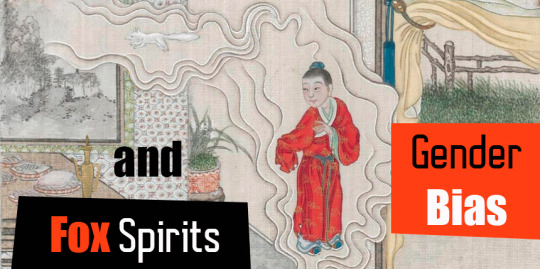
View On WordPress
#ancient China#Chinese culture#Chinese fairy tales#Chinese folk religion#Chinese history#Chinese mythology#fox#Nine-tailed fox#spiritual animal#Tang dynasty#Taoism#Taoist magic#Taoist practices
170 notes
·
View notes
Note
Could Princess Kaguya from Japanese mythology kill Macbeth?
Yes, Princess Kaguya from the Tale of the Bamboo Cutter could kill Macbeth!

A celestial princess born from a glowing stalk of bamboo upon it being cut open by a man named Taketori no Okina, she applies for the Gender Clause, Unconventional Birth Clause, and Birth Parent Clause!
Thank you for your submission!
#asks#unconventional birth clause#gender clause#birth parent clause#princess kaguya#japanese mythology#tale of the bamboo cutter
183 notes
·
View notes